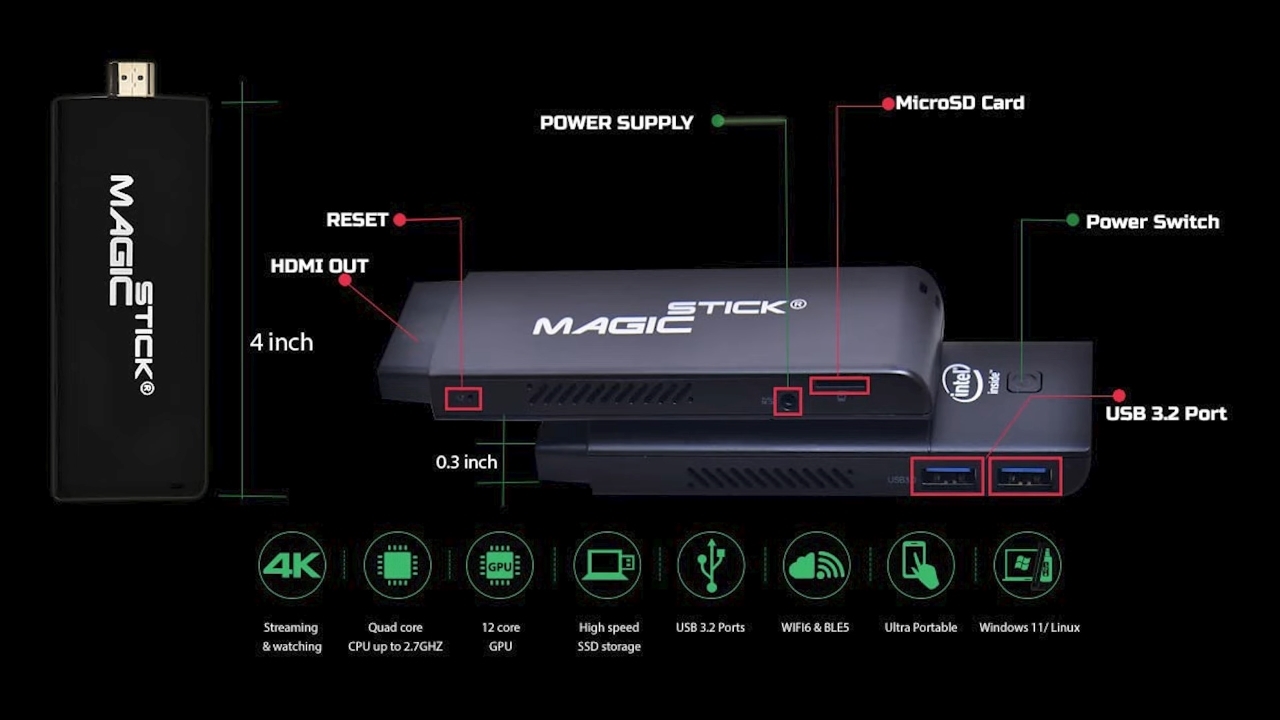In This Article
What is Stick Computer?
A stick computer, also known as a PC stick, refers to a miniature personal computer encased in a small dongle.
From a technical perspective, a computer stick refers to a single-board computer that comes with independent processing chips and needs only a screen to use them.
KEY TAKEAWAYS
- A stick PC is a computer in a small dongle that does not rely on another computer to operate.
- These specially designed computers only need a display to be used because they come with their own Central Processing Units and other components.
- These systems can be very useful since they can be connected to any video port without needing a cable and support other peripheral options.
- PC sticks can produce audio and video output, but usually they have limited computing power, disallowing them to be used for intensive tasks.
- Even though these computer systems come with low storage and other downsides, they offer a lot of significant benefits.
Understanding Stick Computer

A stick computer resembles a Universal Serial Bus or USB drive, so much that it can be easily confused as a storage device. However, these are complete computer systems that come with their own processing unit.
These special computers are known by different names, such as:
- A screen less PC
- A PC stick
- An any-screen computer
- A PC on a stick
- A compute stick
A stick computer can be connected to a display such as a TV or a monitor through a video port such as HDMI, or High-Definition Multimedia Interface.
Several Bluetooth peripherals can be used to control these specially designed computer systems.
There are also a few specific types of PC sticks available that are typically designed to perform specific tasks only, such as:
- The Amazon Fire TV Stick
- Google Chromecast
These systems are designed to run on specific types of operating systems that allow them to only allow media consumption.
There are also other types of computer sticks, such as:
- The ASUS Chromebit
- The Intel W5 Pro Mini PC
These PC sticks can run a whole operating system, but even then, they can perform only simple and specific types of tasks. This is mainly due to their hardware limitations.
The unique features of these computer systems typically are:
- They use an Atom or Advanced RISC Machine (ARM) CPU, usually the mobile variants.
- The operating systems used by these computer systems are usually Windows or Linux.
Some other components of the PC sticks are:
- Graphics processors
- Random Access Memory
- Flash memory storage
- Wi-Fi
- Bluetooth
- An HDMI connector
A few models may also come with additional connectivity support such as:
- A micro USB
- A microSD card slot
- A USB 2.0/3.0 port
These allow further storage expansion.
There are even a few specific models of PC sticks that come with mobile apps and may be used as digital keyboards.
Once these computer sticks are plugged into the HDMI port, the boot sequence will be initiated.
You can view the desktop of the computer system when you switch to the HDMI port input of the TV or the monitor.
You will have a completely functional computer system once you pair a mouse and a keyboard to the stick via a local wireless network.
You may need to set up the operating system to start working.
Is a Stick Computer Good?
Yes, a stick computer is good, albeit within its limitations. These PCs are usually good to use by those people who are looking for an instant computer to set up only needing a screen.
A few other good reasons to use the computer sticks are:
- They are extremely portable.
- They need only a little bit of computing power.
However, the stick PCs are not as powerful as the laptop computers and therefore you should not expect to do everything that you are allowed to do on your laptop or your desktop computer.
Using these PCs will not allow you to run CPU or GPU intensive programs such as Pro Tools, Photoshop, or play those high-end Triple A or online 3D games. You will also not be able to multitask using a stick computer either.
Still, the fast processor and peripheral options will prove your money’s worth, even though these computers are quite expensive.
A stick computer is good to use for the following:
- Work anywhere
- Browse the internet
- Check emails
- Stream videos
- Access social media
However, in spite of the downsides, there are a few concerns about these small computing systems, which include:
- Security issues
- Chances of getting lost easily
- Little storage
- No in-built mouse or keyboard
- May not allow using Wi-Fi and Bluetooth at the same time
- Low processing power
How are Stick Computers Powered?
The stick computers do not come with any in-built batteries. Therefore, they are typically powered by the devices they are linked to.
This means that they will draw the required power from the power supply of the screen.
Conclusion
A stick computer is a good and useful system to use for light computing tasks.
As you can see, the hardware limitations of these specially designed computer systems will not allow doing intensive computing tasks, but the features and options offered by them will provide a good value in return to your investment.